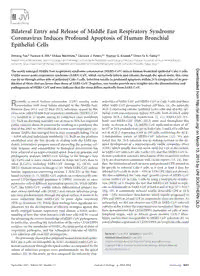
2013 Bilateral Entry and Release of Middle East Respiratory Syndrome Coronavirus Induces Profound Apoptosis of Human Bro PDF
Preview 2013 Bilateral Entry and Release of Middle East Respiratory Syndrome Coronavirus Induces Profound Apoptosis of Human Bro
Bilateral Entry and Release of Middle East Respiratory Syndrome Coronavirus Induces Profound Apoptosis of Human Bronchial Epithelial Cells Xinrong Tao,a Terence E. Hill,a Chikao Morimoto,d Clarence J. Peters,a,c Thomas G. Ksiazek,b Chien-Te K. Tsenga,c Departments of Microbiology and Immunologya and Pathologyb and Center for Biodefense and Emerging Infectious Disease,c University of Texas Medical Branch, Galveston, Texas; Department of Therapy Development and Innovation for Immune Diseases and Cancer, Juntendo University, Tokyo, Japand The newly emerged Middle East respiratory syndrome coronavirus (MERS-CoV) infects human bronchial epithelial Calu-3 cells. Unlike severe acute respiratory syndrome (SARS)-CoV, which exclusively infects and releases through the apical route, this virus can do so through either side of polarized Calu-3 cells. Infection results in profound apoptosis within 24 h irrespective of its pro- duction of titers that are lower than those of SARS-CoV. Together, our results provide new insights into the dissemination and pathogenesis of MERS-CoV and may indicate that the virus differs markedly from SARS-CoV. R ecently, a novel human coronavirus (CoV) causing acute pneumonia with renal failure emerged in the Middle East. Between June 2012 and 22 May 2013, infections caused by this virus, now called Middle East respiratory syndrome (MERS)-CoV (1), resulted in 21 deaths among 43 confirmed cases worldwide (2). Such an alarming mortality rate of close to 50% has reignited public concern about its potential for resulting in a pandemic like that of the 2002-to-2003 outbreak of severe acute respiratory syn- drome (SARS) that emerged first in Asia, eventually killing 774 of �8,000 infected individuals worldwide (3). Built on the platform established over the last decade in dealing with the SARS epi- demic, tremendous progress toward unraveling the genome, cel- lular tropism, and susceptibility to biological intervention has been achieved at an unprecedented speed. Based on genomic and phylogenetic analyses, MERS-CoV belongs to the lineage c beta (�)-CoVs and is more closely related to Asian bat CoVs than to other �-CoVs, including SARS-CoV (lineage b), OC43, and HKU1 (human viruses in lineage a) (4). While SARS-CoV utilizes human angiotensin-converting enzyme 2 (hACE2) as the func- tional receptor (5–7), MERS-CoV exploits an evolutionarily con- served CD26/dipeptidyl peptidase 4 (DPP4) molecule to enter permissive cells of different mammalian species (8). While MERS- CoV, like SARS-CoV, readily infects differentiated primary hu- man airway epithelial cells (HAEC) and releases infectious prog- eny virus predominantly through the apical surface, it seems to be more vulnerable than SARS-CoV to prior alpha interferon (IFN-�) treatment (9). While these findings have significant im- plications for the development of effective strategies against this newly emerged human respiratory viral disease, a better under- standing of how this virus interacts with host cells will be crucial for advancing the current knowledge of MERS-CoV pathogenesis. In particular, unveiling the distribution of the entry CD26/DPP4 receptor, on the membrane of HAEC, the main portal of entry of respiratory pathogens, and the subsequent outcome of MERS- CoV infection still await full investigation. We previously showed that polarized human bronchial epithe- lial Calu-3 cells are susceptible to ACE2-mediated SARS-CoV in- fection exclusively through the apical surface accompanied by the release of infectious progeny virus predominantly via the apical surface (10). In this study, we first compared the infectivity char- acteristics of SARS-CoV and MERS-CoV in Calu-3 cells and three other SARS-CoV-permissive human cell lines, i.e., the naturally ACE-2-expressing colonic epithelial LoVo cells and alveolar epi- thelial A549 and embryonic kidney 293 cells, both of which stably express ACE-2 following transfection (5, 11). SARS-CoV (Ur- bani) and MERS-CoV (EMC-2012) were used throughout this study. As shown in Fig. 1A, MERS-CoV replicated to titers of 105 to 106 at 24 h postinfection (pi) in both Calu-3 and LoVo cells but not in ACE-2-expressing A549 or 293 cells, confirming the ACE- 2-independent nature of MERS-CoV infection (12). We also noted that the 24-h infection was in striking contrast to the de- layed development of a microscopically visible cytopathic effect (CPE), which usually does not occur until day 5 pi, at the earliest, in SARS-CoV-infected Calu-3 cells (10), and that MERS-CoV in- fection resulted in extensive detachment of the monolayer within 24 h, an observation consistent with recent reports (13, 14). Fur- ther, the formation of such an acute and profound CPE seemed to be specific to infected Calu-3 cells, as it took at least 4 days for infected LoVo cells to show �10% to 15% CPE (data not shown). We also established the “one-step” growth curves of MERS-CoV versus SARS-CoV in Calu-3 cells by using a multiplicity of infec- tion (MOI) of 3. Despite the fact that MERS-CoV failed to repli- cate as dynamically as SARS-CoV at both 8 and 32 h pi (P � 0.01) (Fig. 1B), it consistently induced readily detectable CPE at 16 h with �20% monolayer detachment, which rapidly progressed to 70% and 100% at 24 and 32 h pi, respectively (data not shown). As anticipated, we did not observe any CPE in SARS-CoV-infected cultures at day 4 when the experiment was terminated. Since it has been demonstrated that CD26/DPP4 expression on cells of non- lymphoid origin, such as African green monkey COS-7 fibro- blasts, confers their susceptibility to MERS-CoV infection (8), we asked whether expression of CD26/DPP4 on lymphoid cells could Received 27 June 2013 Accepted 27 June 2013 Published ahead of print 3 July 2013 Address correspondence to Chien-Te K. Tseng,
